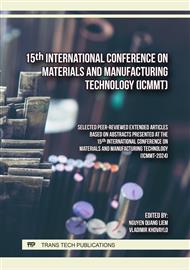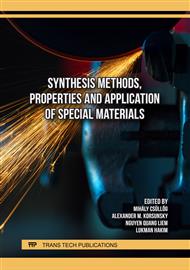p.71
p.81
p.87
p.97
p.109
p.119
p.131
p.137
p.143
Fabrication of Metal Particles Using Differences in Standard Electrode Potentials
Abstract:
This study proposes a simple method for fabricating metal particles. Metal nanoparticles are synthesized in an aqueous solution. The synthesis method is based on the galvanic replacement of one metal with another, i.e., the deposition of a metal on the surface of another metal using difference between the standard electrode potentials of the metals under ultrasonication. An aqueous colloidal solution of metallic copper (Cu) nanoparticles is prepared using Cu acetate and a metallic zinc (Zn) plate. A similar colloidal solution of metallic Cu nanoparticles is prepared using Cu acetate and a metallic iron plate. No metallic nanoparticles are obtained using metallic aluminum and nickel (Ni) plates because of the formation of passivated layers. An aqueous colloidal solution of metallic Ni nanoparticles is prepared using Ni acetate and a metallic Zn plate; however, Ni0.7Zn0.3O is also formed. The results of the study show that the proposed method can be used to produce metallic particles in a simple manner.
Info:
Periodical:
Pages:
131-136
Citation:
Online since:
September 2024
Authors:
Keywords:
Price:
Сopyright:
© 2024 Trans Tech Publications Ltd. All Rights Reserved
Share:
Citation:



